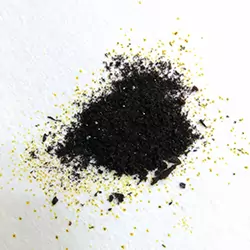IUPAC Name
Iron trichloride
Cas Number
7705-08-0
HS Code
38220090
Formula
Cl3 Fe
Industry
Water Treatment Chemicals
Appearance
Powder Dark Color
Common Names
Iron (III) Chloride, Iron trichloride, Molysite
Packaging
50 kg PP Bag
Brief Overview
Ferric Chloride (Iron(III) Chloride) is a brown to black coloured inorganic compound with the chemical formula FeCl3. Ferric Chloride occurs naturally in the form of a mineral named molysite. It forms an exothermic reaction when undergoing hydrolysis, thus forming a very corrosive brown coloured acidic solution which is used in widespread applications such as sewage treatment, water purification, etching printed circuit boards, and as a catalyst in organic synthesis reactions. It has a low melting point but a relatively high boiling point of 319∘C.
Manufacturing Process
Ferric Chloride is commercially manufactured in an ebonized reactor. Hydrochloric acid and ferric oxide are combined in the reactor, stirred, and heated. The reaction is exothermic and will generate heat. This reaction is carried out at a constant temperature of between 80 to 90∘C and at atmospheric pressure for about five hours. As the reaction reaches completion, the mixture is allowed to remain in the reactor for an additional 10 to 12 hours such that sedimentation of the excess ferric oxide occurs. The resulting ferric oxide is separated, washed, dried, and sent for size reduction operations to obtain the size required as per customers’ demands.
Laboratory
When in the hydrated form, it tends to act as a Lewis Acid which is therefore used for catalysing various reactions such as Friedel Crafts Reaction for aromatics and chlorination of aromatic compounds.
Waste Water Treatment and Water Purification
Ferric Chloride is most widely utilized in the hydrated form for treating waste water and for purifying drinking water.
Other Applications
It is used in chloride hydrometallurgy as a leaching agent in applications which involve the conversion of Ferrosilicon to Silicon. It is also used as a catalyst for reactions such as that of Ethylene and Chlorine, and it is also used for etching copper. It is also used in the manufacture of dyes, pigments, and inks, as a chlorinating agent, and as a catalyst in chlorination reactions of aromatics.
